Case Study: Asthma Pathophysiology, Pharmacology, and Symptoms
VerifiedAdded on 2022/09/14
|9
|2988
|13
Case Study
AI Summary
This case study focuses on a 5-year-old girl named Jessica, who presents with asthma, detailing her medical history, symptoms, and treatment. The assignment explores the pathophysiology of asthma, including the respiratory system's functions and the mechanisms of airway inflammation. It examines the pharmacology of medications like salbutamol, ipratropium, and prednisone, explaining their actions and effects on the patient. The case study also analyzes Jessica's presenting symptoms, such as coughing, wheezing, and shortness of breath, linking them to the underlying pathophysiology. The document covers the clinical interventions, including medication administration and monitoring of vital signs, as well as the patient's recovery and discharge plan, emphasizing the importance of education for both the patient and her mother. The assignment provides a comprehensive overview of asthma management, integrating medical knowledge with practical clinical scenarios.
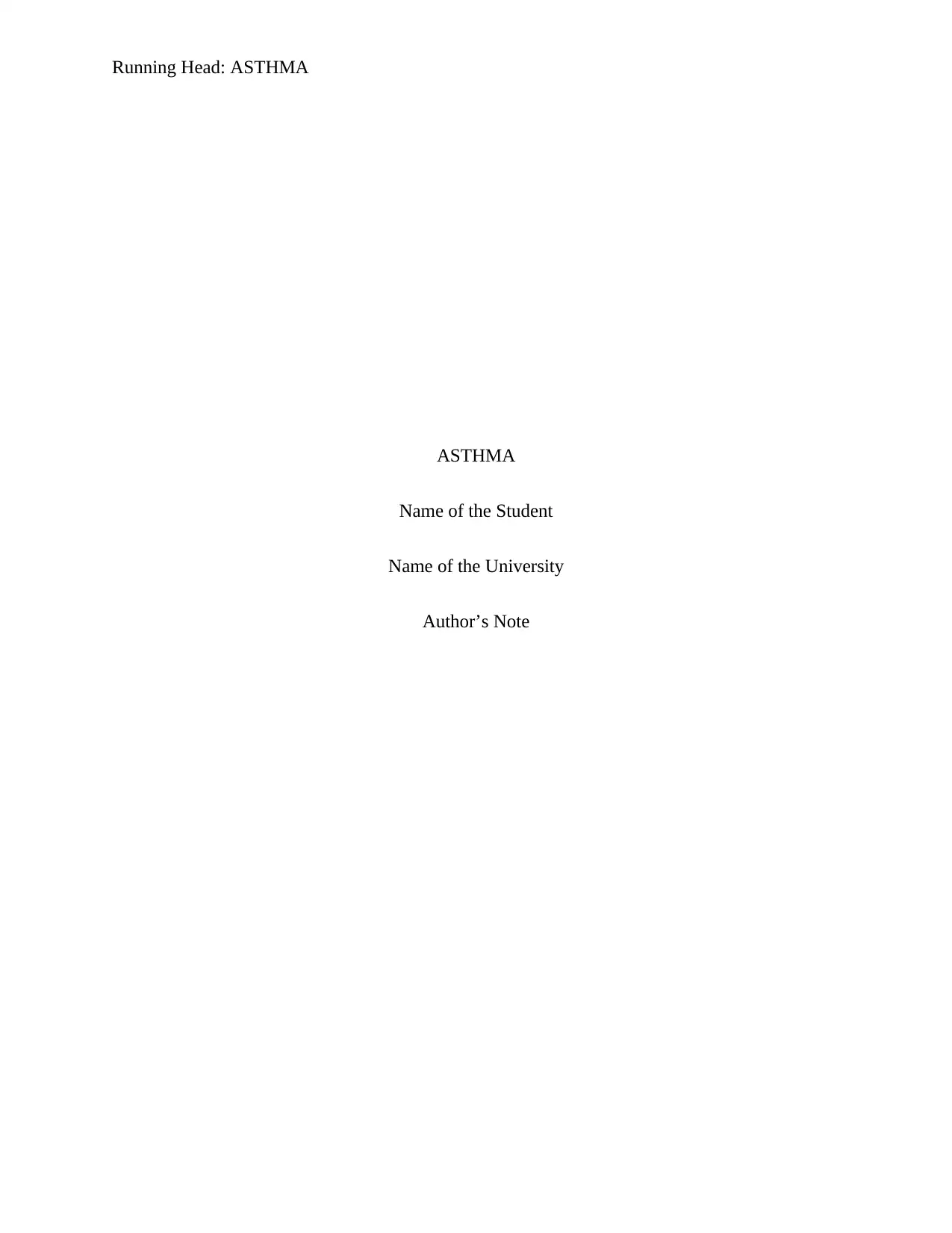
Running Head: ASTHMA
ASTHMA
Name of the Student
Name of the University
Author’s Note
ASTHMA
Name of the Student
Name of the University
Author’s Note
Paraphrase This Document
Need a fresh take? Get an instant paraphrase of this document with our AI Paraphraser
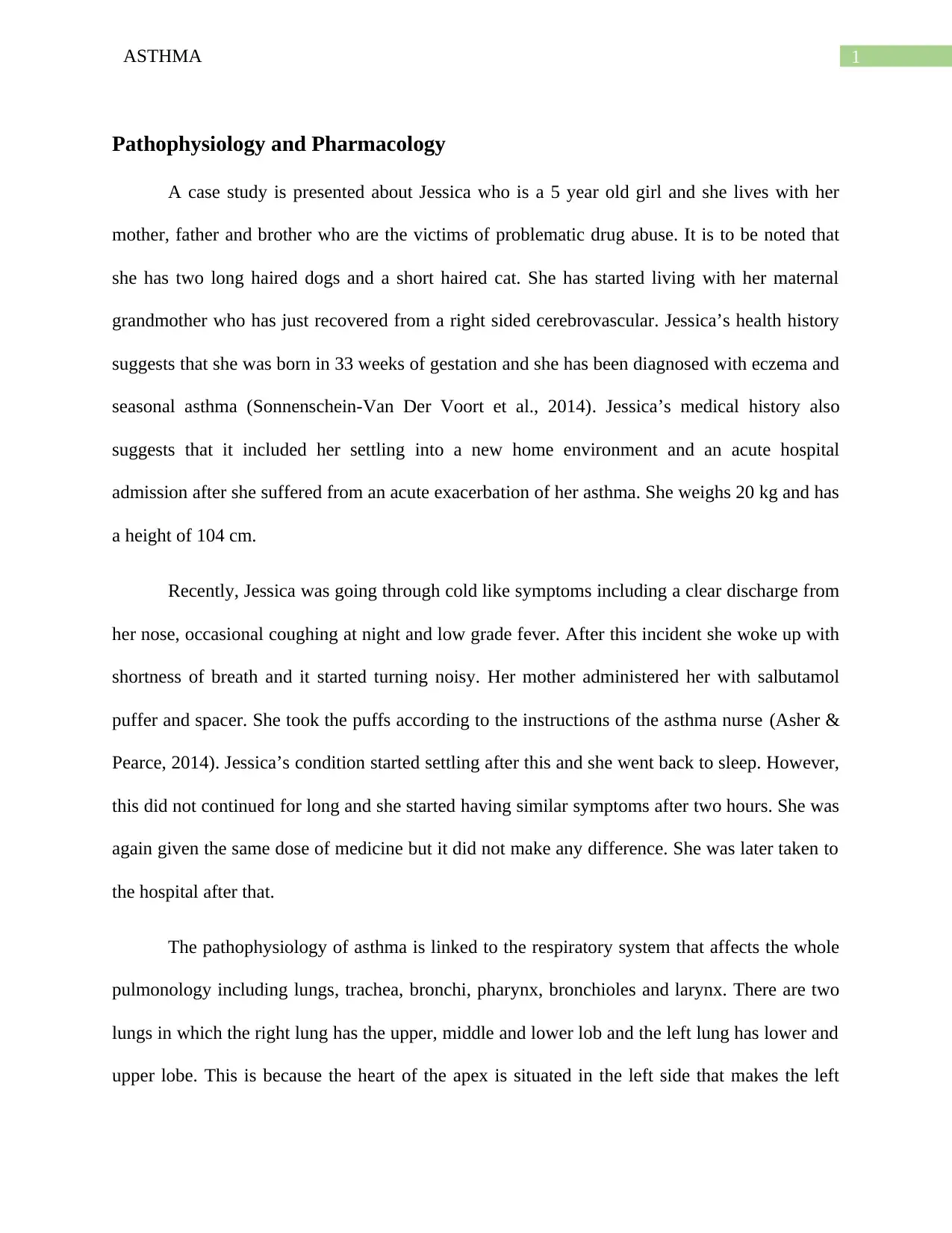
1ASTHMA
Pathophysiology and Pharmacology
A case study is presented about Jessica who is a 5 year old girl and she lives with her
mother, father and brother who are the victims of problematic drug abuse. It is to be noted that
she has two long haired dogs and a short haired cat. She has started living with her maternal
grandmother who has just recovered from a right sided cerebrovascular. Jessica’s health history
suggests that she was born in 33 weeks of gestation and she has been diagnosed with eczema and
seasonal asthma (Sonnenschein-Van Der Voort et al., 2014). Jessica’s medical history also
suggests that it included her settling into a new home environment and an acute hospital
admission after she suffered from an acute exacerbation of her asthma. She weighs 20 kg and has
a height of 104 cm.
Recently, Jessica was going through cold like symptoms including a clear discharge from
her nose, occasional coughing at night and low grade fever. After this incident she woke up with
shortness of breath and it started turning noisy. Her mother administered her with salbutamol
puffer and spacer. She took the puffs according to the instructions of the asthma nurse (Asher &
Pearce, 2014). Jessica’s condition started settling after this and she went back to sleep. However,
this did not continued for long and she started having similar symptoms after two hours. She was
again given the same dose of medicine but it did not make any difference. She was later taken to
the hospital after that.
The pathophysiology of asthma is linked to the respiratory system that affects the whole
pulmonology including lungs, trachea, bronchi, pharynx, bronchioles and larynx. There are two
lungs in which the right lung has the upper, middle and lower lob and the left lung has lower and
upper lobe. This is because the heart of the apex is situated in the left side that makes the left
Pathophysiology and Pharmacology
A case study is presented about Jessica who is a 5 year old girl and she lives with her
mother, father and brother who are the victims of problematic drug abuse. It is to be noted that
she has two long haired dogs and a short haired cat. She has started living with her maternal
grandmother who has just recovered from a right sided cerebrovascular. Jessica’s health history
suggests that she was born in 33 weeks of gestation and she has been diagnosed with eczema and
seasonal asthma (Sonnenschein-Van Der Voort et al., 2014). Jessica’s medical history also
suggests that it included her settling into a new home environment and an acute hospital
admission after she suffered from an acute exacerbation of her asthma. She weighs 20 kg and has
a height of 104 cm.
Recently, Jessica was going through cold like symptoms including a clear discharge from
her nose, occasional coughing at night and low grade fever. After this incident she woke up with
shortness of breath and it started turning noisy. Her mother administered her with salbutamol
puffer and spacer. She took the puffs according to the instructions of the asthma nurse (Asher &
Pearce, 2014). Jessica’s condition started settling after this and she went back to sleep. However,
this did not continued for long and she started having similar symptoms after two hours. She was
again given the same dose of medicine but it did not make any difference. She was later taken to
the hospital after that.
The pathophysiology of asthma is linked to the respiratory system that affects the whole
pulmonology including lungs, trachea, bronchi, pharynx, bronchioles and larynx. There are two
lungs in which the right lung has the upper, middle and lower lob and the left lung has lower and
upper lobe. This is because the heart of the apex is situated in the left side that makes the left
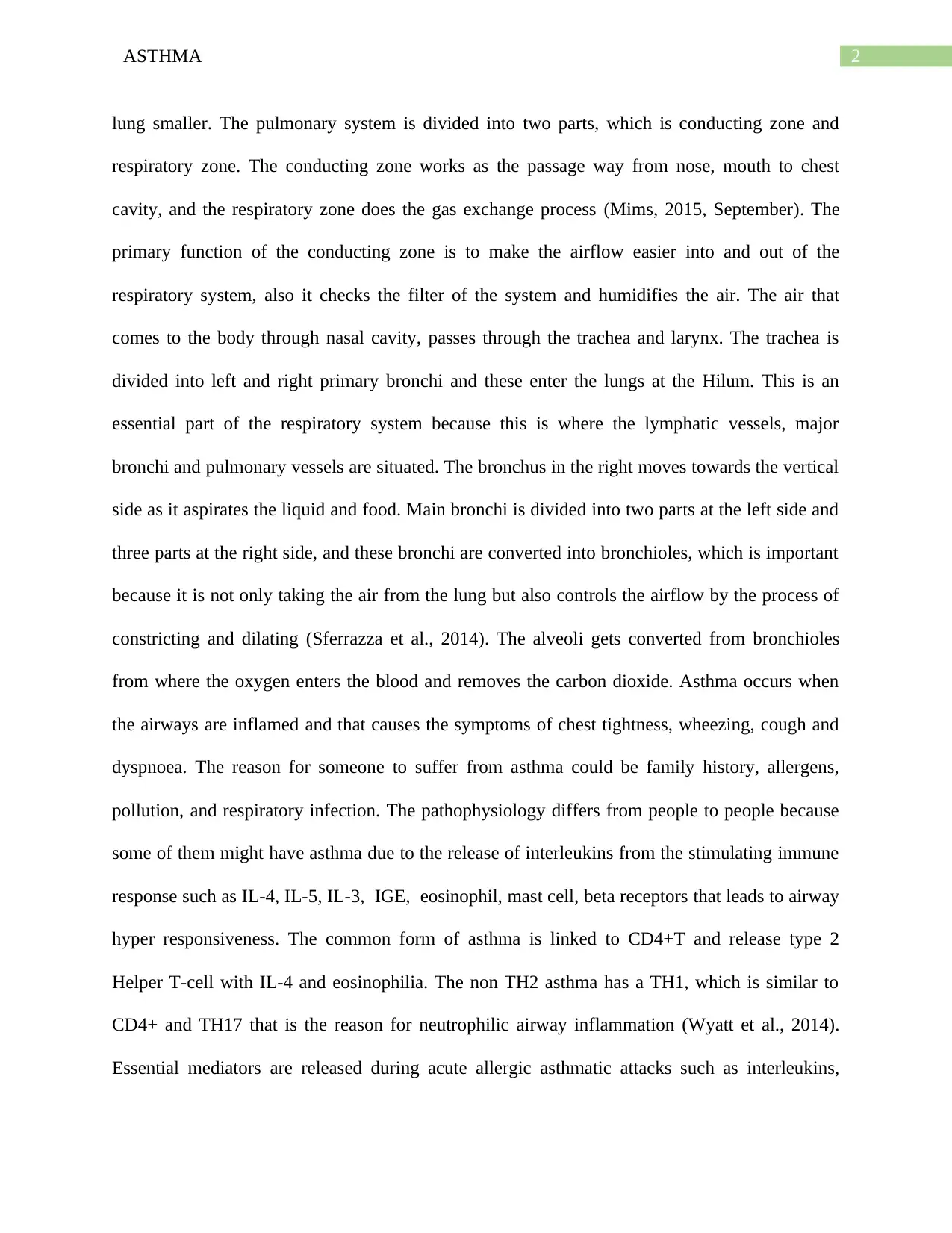
2ASTHMA
lung smaller. The pulmonary system is divided into two parts, which is conducting zone and
respiratory zone. The conducting zone works as the passage way from nose, mouth to chest
cavity, and the respiratory zone does the gas exchange process (Mims, 2015, September). The
primary function of the conducting zone is to make the airflow easier into and out of the
respiratory system, also it checks the filter of the system and humidifies the air. The air that
comes to the body through nasal cavity, passes through the trachea and larynx. The trachea is
divided into left and right primary bronchi and these enter the lungs at the Hilum. This is an
essential part of the respiratory system because this is where the lymphatic vessels, major
bronchi and pulmonary vessels are situated. The bronchus in the right moves towards the vertical
side as it aspirates the liquid and food. Main bronchi is divided into two parts at the left side and
three parts at the right side, and these bronchi are converted into bronchioles, which is important
because it is not only taking the air from the lung but also controls the airflow by the process of
constricting and dilating (Sferrazza et al., 2014). The alveoli gets converted from bronchioles
from where the oxygen enters the blood and removes the carbon dioxide. Asthma occurs when
the airways are inflamed and that causes the symptoms of chest tightness, wheezing, cough and
dyspnoea. The reason for someone to suffer from asthma could be family history, allergens,
pollution, and respiratory infection. The pathophysiology differs from people to people because
some of them might have asthma due to the release of interleukins from the stimulating immune
response such as IL-4, IL-5, IL-3, IGE, eosinophil, mast cell, beta receptors that leads to airway
hyper responsiveness. The common form of asthma is linked to CD4+T and release type 2
Helper T-cell with IL-4 and eosinophilia. The non TH2 asthma has a TH1, which is similar to
CD4+ and TH17 that is the reason for neutrophilic airway inflammation (Wyatt et al., 2014).
Essential mediators are released during acute allergic asthmatic attacks such as interleukins,
lung smaller. The pulmonary system is divided into two parts, which is conducting zone and
respiratory zone. The conducting zone works as the passage way from nose, mouth to chest
cavity, and the respiratory zone does the gas exchange process (Mims, 2015, September). The
primary function of the conducting zone is to make the airflow easier into and out of the
respiratory system, also it checks the filter of the system and humidifies the air. The air that
comes to the body through nasal cavity, passes through the trachea and larynx. The trachea is
divided into left and right primary bronchi and these enter the lungs at the Hilum. This is an
essential part of the respiratory system because this is where the lymphatic vessels, major
bronchi and pulmonary vessels are situated. The bronchus in the right moves towards the vertical
side as it aspirates the liquid and food. Main bronchi is divided into two parts at the left side and
three parts at the right side, and these bronchi are converted into bronchioles, which is important
because it is not only taking the air from the lung but also controls the airflow by the process of
constricting and dilating (Sferrazza et al., 2014). The alveoli gets converted from bronchioles
from where the oxygen enters the blood and removes the carbon dioxide. Asthma occurs when
the airways are inflamed and that causes the symptoms of chest tightness, wheezing, cough and
dyspnoea. The reason for someone to suffer from asthma could be family history, allergens,
pollution, and respiratory infection. The pathophysiology differs from people to people because
some of them might have asthma due to the release of interleukins from the stimulating immune
response such as IL-4, IL-5, IL-3, IGE, eosinophil, mast cell, beta receptors that leads to airway
hyper responsiveness. The common form of asthma is linked to CD4+T and release type 2
Helper T-cell with IL-4 and eosinophilia. The non TH2 asthma has a TH1, which is similar to
CD4+ and TH17 that is the reason for neutrophilic airway inflammation (Wyatt et al., 2014).
Essential mediators are released during acute allergic asthmatic attacks such as interleukins,
⊘ This is a preview!⊘
Do you want full access?
Subscribe today to unlock all pages.

Trusted by 1+ million students worldwide
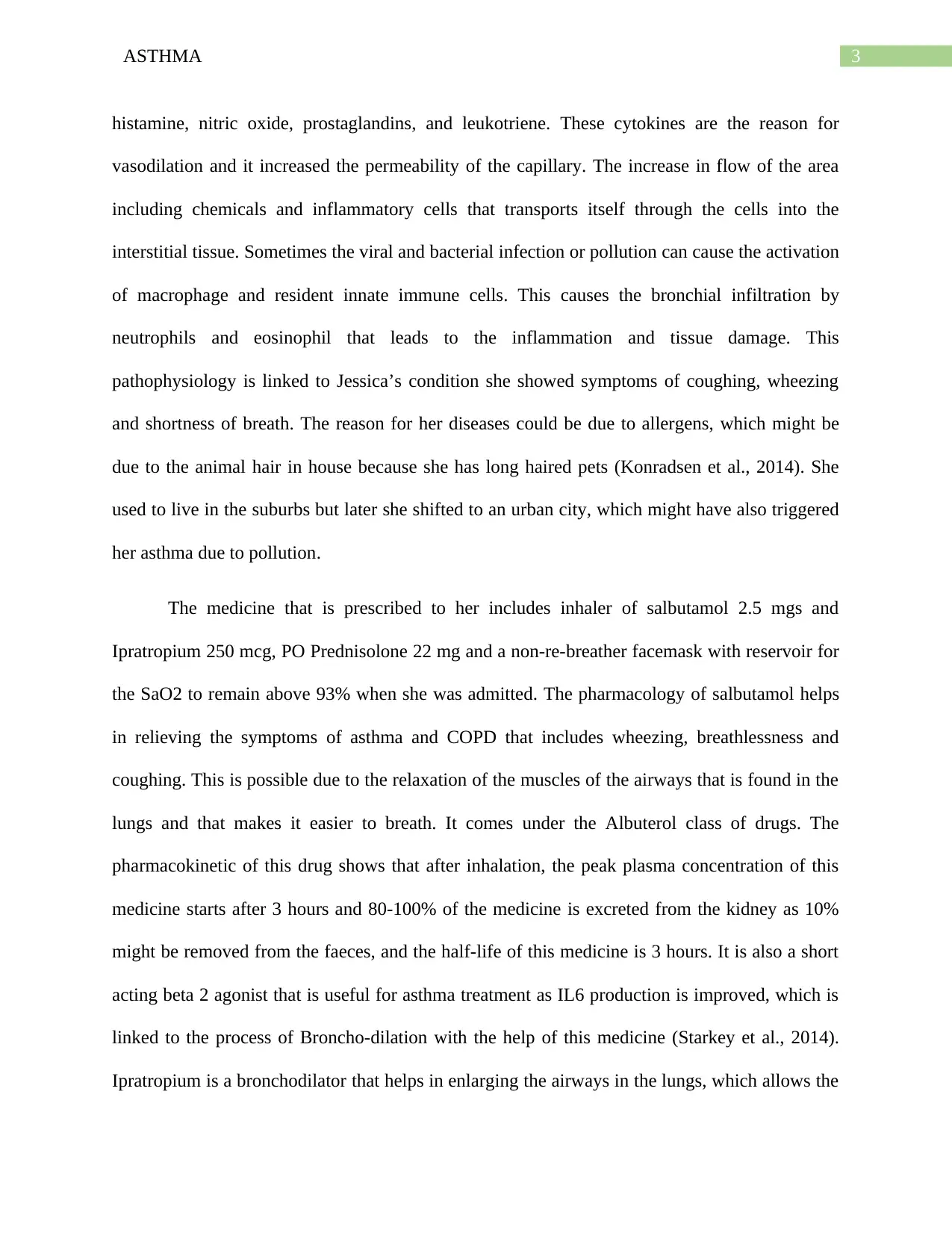
3ASTHMA
histamine, nitric oxide, prostaglandins, and leukotriene. These cytokines are the reason for
vasodilation and it increased the permeability of the capillary. The increase in flow of the area
including chemicals and inflammatory cells that transports itself through the cells into the
interstitial tissue. Sometimes the viral and bacterial infection or pollution can cause the activation
of macrophage and resident innate immune cells. This causes the bronchial infiltration by
neutrophils and eosinophil that leads to the inflammation and tissue damage. This
pathophysiology is linked to Jessica’s condition she showed symptoms of coughing, wheezing
and shortness of breath. The reason for her diseases could be due to allergens, which might be
due to the animal hair in house because she has long haired pets (Konradsen et al., 2014). She
used to live in the suburbs but later she shifted to an urban city, which might have also triggered
her asthma due to pollution.
The medicine that is prescribed to her includes inhaler of salbutamol 2.5 mgs and
Ipratropium 250 mcg, PO Prednisolone 22 mg and a non-re-breather facemask with reservoir for
the SaO2 to remain above 93% when she was admitted. The pharmacology of salbutamol helps
in relieving the symptoms of asthma and COPD that includes wheezing, breathlessness and
coughing. This is possible due to the relaxation of the muscles of the airways that is found in the
lungs and that makes it easier to breath. It comes under the Albuterol class of drugs. The
pharmacokinetic of this drug shows that after inhalation, the peak plasma concentration of this
medicine starts after 3 hours and 80-100% of the medicine is excreted from the kidney as 10%
might be removed from the faeces, and the half-life of this medicine is 3 hours. It is also a short
acting beta 2 agonist that is useful for asthma treatment as IL6 production is improved, which is
linked to the process of Broncho-dilation with the help of this medicine (Starkey et al., 2014).
Ipratropium is a bronchodilator that helps in enlarging the airways in the lungs, which allows the
histamine, nitric oxide, prostaglandins, and leukotriene. These cytokines are the reason for
vasodilation and it increased the permeability of the capillary. The increase in flow of the area
including chemicals and inflammatory cells that transports itself through the cells into the
interstitial tissue. Sometimes the viral and bacterial infection or pollution can cause the activation
of macrophage and resident innate immune cells. This causes the bronchial infiltration by
neutrophils and eosinophil that leads to the inflammation and tissue damage. This
pathophysiology is linked to Jessica’s condition she showed symptoms of coughing, wheezing
and shortness of breath. The reason for her diseases could be due to allergens, which might be
due to the animal hair in house because she has long haired pets (Konradsen et al., 2014). She
used to live in the suburbs but later she shifted to an urban city, which might have also triggered
her asthma due to pollution.
The medicine that is prescribed to her includes inhaler of salbutamol 2.5 mgs and
Ipratropium 250 mcg, PO Prednisolone 22 mg and a non-re-breather facemask with reservoir for
the SaO2 to remain above 93% when she was admitted. The pharmacology of salbutamol helps
in relieving the symptoms of asthma and COPD that includes wheezing, breathlessness and
coughing. This is possible due to the relaxation of the muscles of the airways that is found in the
lungs and that makes it easier to breath. It comes under the Albuterol class of drugs. The
pharmacokinetic of this drug shows that after inhalation, the peak plasma concentration of this
medicine starts after 3 hours and 80-100% of the medicine is excreted from the kidney as 10%
might be removed from the faeces, and the half-life of this medicine is 3 hours. It is also a short
acting beta 2 agonist that is useful for asthma treatment as IL6 production is improved, which is
linked to the process of Broncho-dilation with the help of this medicine (Starkey et al., 2014).
Ipratropium is a bronchodilator that helps in enlarging the airways in the lungs, which allows the
Paraphrase This Document
Need a fresh take? Get an instant paraphrase of this document with our AI Paraphraser
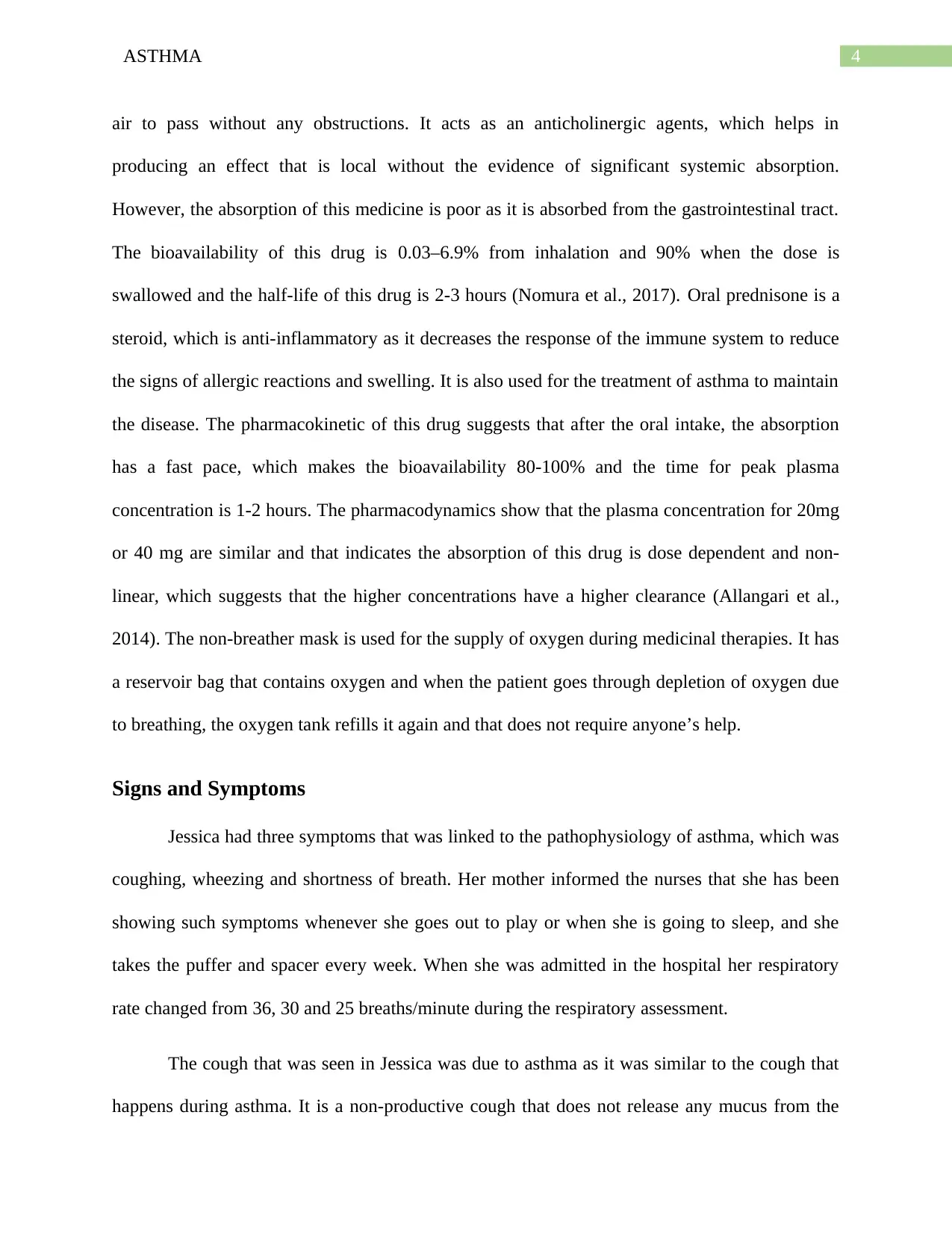
4ASTHMA
air to pass without any obstructions. It acts as an anticholinergic agents, which helps in
producing an effect that is local without the evidence of significant systemic absorption.
However, the absorption of this medicine is poor as it is absorbed from the gastrointestinal tract.
The bioavailability of this drug is 0.03–6.9% from inhalation and 90% when the dose is
swallowed and the half-life of this drug is 2-3 hours (Nomura et al., 2017). Oral prednisone is a
steroid, which is anti-inflammatory as it decreases the response of the immune system to reduce
the signs of allergic reactions and swelling. It is also used for the treatment of asthma to maintain
the disease. The pharmacokinetic of this drug suggests that after the oral intake, the absorption
has a fast pace, which makes the bioavailability 80-100% and the time for peak plasma
concentration is 1-2 hours. The pharmacodynamics show that the plasma concentration for 20mg
or 40 mg are similar and that indicates the absorption of this drug is dose dependent and non-
linear, which suggests that the higher concentrations have a higher clearance (Allangari et al.,
2014). The non-breather mask is used for the supply of oxygen during medicinal therapies. It has
a reservoir bag that contains oxygen and when the patient goes through depletion of oxygen due
to breathing, the oxygen tank refills it again and that does not require anyone’s help.
Signs and Symptoms
Jessica had three symptoms that was linked to the pathophysiology of asthma, which was
coughing, wheezing and shortness of breath. Her mother informed the nurses that she has been
showing such symptoms whenever she goes out to play or when she is going to sleep, and she
takes the puffer and spacer every week. When she was admitted in the hospital her respiratory
rate changed from 36, 30 and 25 breaths/minute during the respiratory assessment.
The cough that was seen in Jessica was due to asthma as it was similar to the cough that
happens during asthma. It is a non-productive cough that does not release any mucus from the
air to pass without any obstructions. It acts as an anticholinergic agents, which helps in
producing an effect that is local without the evidence of significant systemic absorption.
However, the absorption of this medicine is poor as it is absorbed from the gastrointestinal tract.
The bioavailability of this drug is 0.03–6.9% from inhalation and 90% when the dose is
swallowed and the half-life of this drug is 2-3 hours (Nomura et al., 2017). Oral prednisone is a
steroid, which is anti-inflammatory as it decreases the response of the immune system to reduce
the signs of allergic reactions and swelling. It is also used for the treatment of asthma to maintain
the disease. The pharmacokinetic of this drug suggests that after the oral intake, the absorption
has a fast pace, which makes the bioavailability 80-100% and the time for peak plasma
concentration is 1-2 hours. The pharmacodynamics show that the plasma concentration for 20mg
or 40 mg are similar and that indicates the absorption of this drug is dose dependent and non-
linear, which suggests that the higher concentrations have a higher clearance (Allangari et al.,
2014). The non-breather mask is used for the supply of oxygen during medicinal therapies. It has
a reservoir bag that contains oxygen and when the patient goes through depletion of oxygen due
to breathing, the oxygen tank refills it again and that does not require anyone’s help.
Signs and Symptoms
Jessica had three symptoms that was linked to the pathophysiology of asthma, which was
coughing, wheezing and shortness of breath. Her mother informed the nurses that she has been
showing such symptoms whenever she goes out to play or when she is going to sleep, and she
takes the puffer and spacer every week. When she was admitted in the hospital her respiratory
rate changed from 36, 30 and 25 breaths/minute during the respiratory assessment.
The cough that was seen in Jessica was due to asthma as it was similar to the cough that
happens during asthma. It is a non-productive cough that does not release any mucus from the
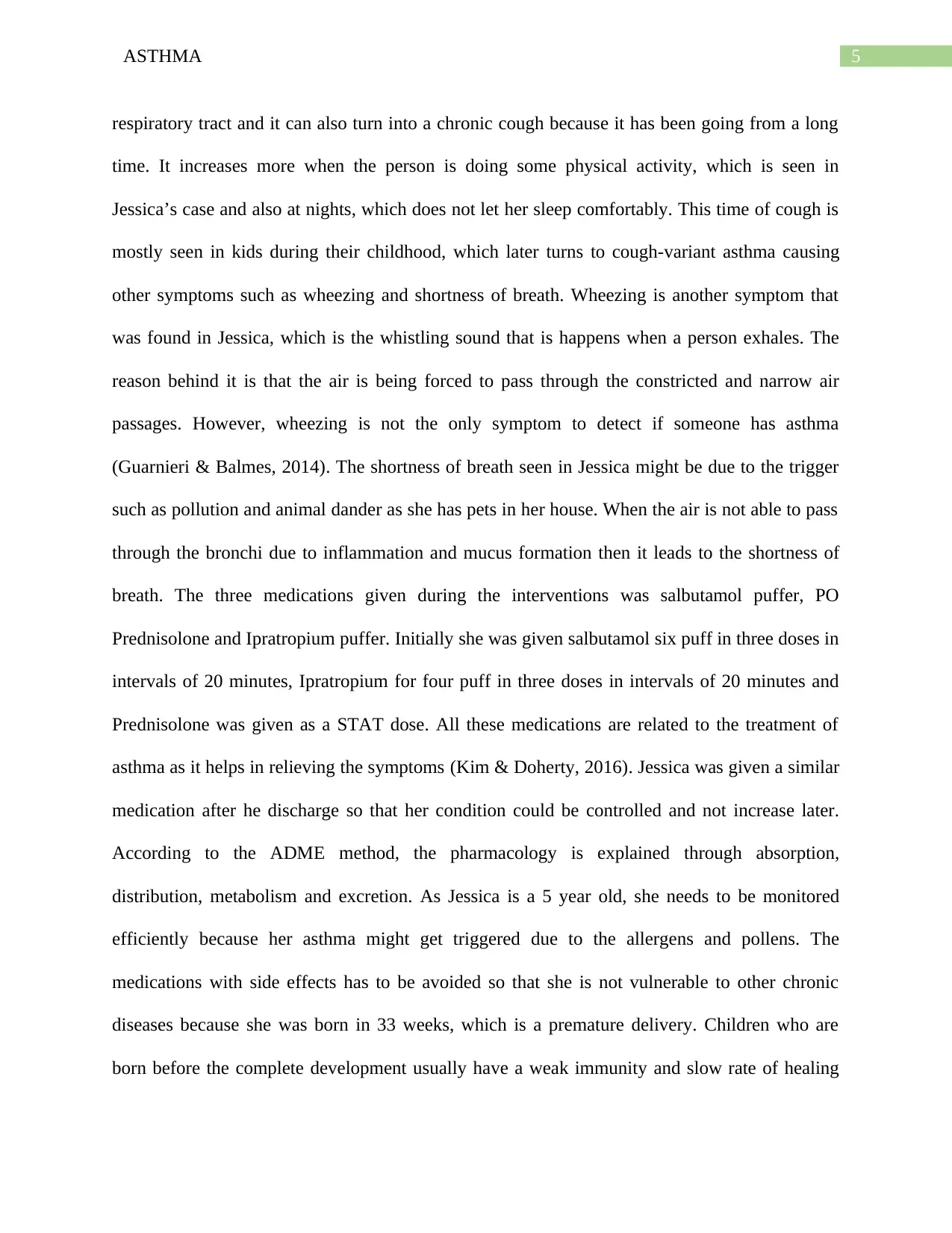
5ASTHMA
respiratory tract and it can also turn into a chronic cough because it has been going from a long
time. It increases more when the person is doing some physical activity, which is seen in
Jessica’s case and also at nights, which does not let her sleep comfortably. This time of cough is
mostly seen in kids during their childhood, which later turns to cough-variant asthma causing
other symptoms such as wheezing and shortness of breath. Wheezing is another symptom that
was found in Jessica, which is the whistling sound that is happens when a person exhales. The
reason behind it is that the air is being forced to pass through the constricted and narrow air
passages. However, wheezing is not the only symptom to detect if someone has asthma
(Guarnieri & Balmes, 2014). The shortness of breath seen in Jessica might be due to the trigger
such as pollution and animal dander as she has pets in her house. When the air is not able to pass
through the bronchi due to inflammation and mucus formation then it leads to the shortness of
breath. The three medications given during the interventions was salbutamol puffer, PO
Prednisolone and Ipratropium puffer. Initially she was given salbutamol six puff in three doses in
intervals of 20 minutes, Ipratropium for four puff in three doses in intervals of 20 minutes and
Prednisolone was given as a STAT dose. All these medications are related to the treatment of
asthma as it helps in relieving the symptoms (Kim & Doherty, 2016). Jessica was given a similar
medication after he discharge so that her condition could be controlled and not increase later.
According to the ADME method, the pharmacology is explained through absorption,
distribution, metabolism and excretion. As Jessica is a 5 year old, she needs to be monitored
efficiently because her asthma might get triggered due to the allergens and pollens. The
medications with side effects has to be avoided so that she is not vulnerable to other chronic
diseases because she was born in 33 weeks, which is a premature delivery. Children who are
born before the complete development usually have a weak immunity and slow rate of healing
respiratory tract and it can also turn into a chronic cough because it has been going from a long
time. It increases more when the person is doing some physical activity, which is seen in
Jessica’s case and also at nights, which does not let her sleep comfortably. This time of cough is
mostly seen in kids during their childhood, which later turns to cough-variant asthma causing
other symptoms such as wheezing and shortness of breath. Wheezing is another symptom that
was found in Jessica, which is the whistling sound that is happens when a person exhales. The
reason behind it is that the air is being forced to pass through the constricted and narrow air
passages. However, wheezing is not the only symptom to detect if someone has asthma
(Guarnieri & Balmes, 2014). The shortness of breath seen in Jessica might be due to the trigger
such as pollution and animal dander as she has pets in her house. When the air is not able to pass
through the bronchi due to inflammation and mucus formation then it leads to the shortness of
breath. The three medications given during the interventions was salbutamol puffer, PO
Prednisolone and Ipratropium puffer. Initially she was given salbutamol six puff in three doses in
intervals of 20 minutes, Ipratropium for four puff in three doses in intervals of 20 minutes and
Prednisolone was given as a STAT dose. All these medications are related to the treatment of
asthma as it helps in relieving the symptoms (Kim & Doherty, 2016). Jessica was given a similar
medication after he discharge so that her condition could be controlled and not increase later.
According to the ADME method, the pharmacology is explained through absorption,
distribution, metabolism and excretion. As Jessica is a 5 year old, she needs to be monitored
efficiently because her asthma might get triggered due to the allergens and pollens. The
medications with side effects has to be avoided so that she is not vulnerable to other chronic
diseases because she was born in 33 weeks, which is a premature delivery. Children who are
born before the complete development usually have a weak immunity and slow rate of healing
⊘ This is a preview!⊘
Do you want full access?
Subscribe today to unlock all pages.

Trusted by 1+ million students worldwide
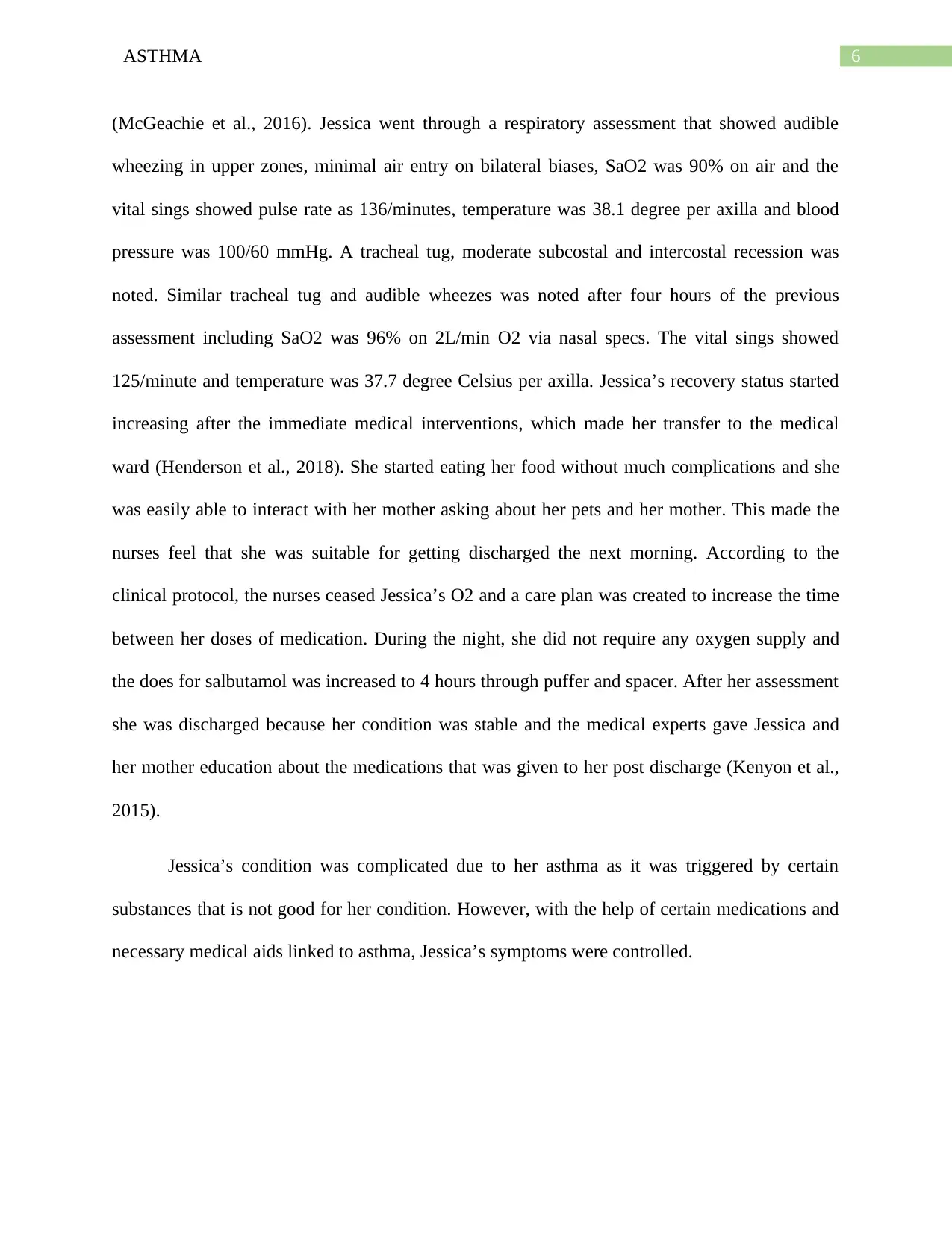
6ASTHMA
(McGeachie et al., 2016). Jessica went through a respiratory assessment that showed audible
wheezing in upper zones, minimal air entry on bilateral biases, SaO2 was 90% on air and the
vital sings showed pulse rate as 136/minutes, temperature was 38.1 degree per axilla and blood
pressure was 100/60 mmHg. A tracheal tug, moderate subcostal and intercostal recession was
noted. Similar tracheal tug and audible wheezes was noted after four hours of the previous
assessment including SaO2 was 96% on 2L/min O2 via nasal specs. The vital sings showed
125/minute and temperature was 37.7 degree Celsius per axilla. Jessica’s recovery status started
increasing after the immediate medical interventions, which made her transfer to the medical
ward (Henderson et al., 2018). She started eating her food without much complications and she
was easily able to interact with her mother asking about her pets and her mother. This made the
nurses feel that she was suitable for getting discharged the next morning. According to the
clinical protocol, the nurses ceased Jessica’s O2 and a care plan was created to increase the time
between her doses of medication. During the night, she did not require any oxygen supply and
the does for salbutamol was increased to 4 hours through puffer and spacer. After her assessment
she was discharged because her condition was stable and the medical experts gave Jessica and
her mother education about the medications that was given to her post discharge (Kenyon et al.,
2015).
Jessica’s condition was complicated due to her asthma as it was triggered by certain
substances that is not good for her condition. However, with the help of certain medications and
necessary medical aids linked to asthma, Jessica’s symptoms were controlled.
(McGeachie et al., 2016). Jessica went through a respiratory assessment that showed audible
wheezing in upper zones, minimal air entry on bilateral biases, SaO2 was 90% on air and the
vital sings showed pulse rate as 136/minutes, temperature was 38.1 degree per axilla and blood
pressure was 100/60 mmHg. A tracheal tug, moderate subcostal and intercostal recession was
noted. Similar tracheal tug and audible wheezes was noted after four hours of the previous
assessment including SaO2 was 96% on 2L/min O2 via nasal specs. The vital sings showed
125/minute and temperature was 37.7 degree Celsius per axilla. Jessica’s recovery status started
increasing after the immediate medical interventions, which made her transfer to the medical
ward (Henderson et al., 2018). She started eating her food without much complications and she
was easily able to interact with her mother asking about her pets and her mother. This made the
nurses feel that she was suitable for getting discharged the next morning. According to the
clinical protocol, the nurses ceased Jessica’s O2 and a care plan was created to increase the time
between her doses of medication. During the night, she did not require any oxygen supply and
the does for salbutamol was increased to 4 hours through puffer and spacer. After her assessment
she was discharged because her condition was stable and the medical experts gave Jessica and
her mother education about the medications that was given to her post discharge (Kenyon et al.,
2015).
Jessica’s condition was complicated due to her asthma as it was triggered by certain
substances that is not good for her condition. However, with the help of certain medications and
necessary medical aids linked to asthma, Jessica’s symptoms were controlled.
Paraphrase This Document
Need a fresh take? Get an instant paraphrase of this document with our AI Paraphraser
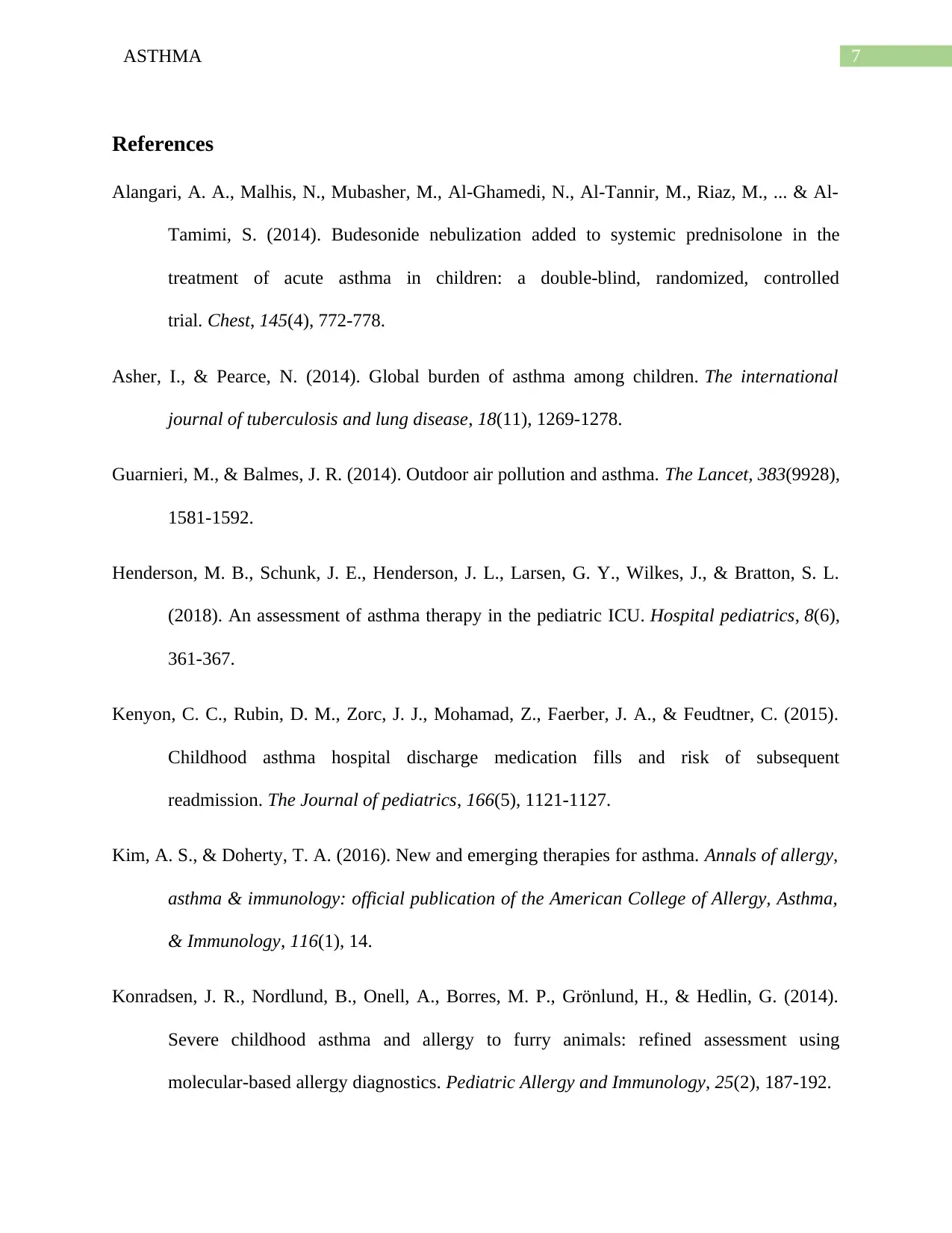
7ASTHMA
References
Alangari, A. A., Malhis, N., Mubasher, M., Al-Ghamedi, N., Al-Tannir, M., Riaz, M., ... & Al-
Tamimi, S. (2014). Budesonide nebulization added to systemic prednisolone in the
treatment of acute asthma in children: a double-blind, randomized, controlled
trial. Chest, 145(4), 772-778.
Asher, I., & Pearce, N. (2014). Global burden of asthma among children. The international
journal of tuberculosis and lung disease, 18(11), 1269-1278.
Guarnieri, M., & Balmes, J. R. (2014). Outdoor air pollution and asthma. The Lancet, 383(9928),
1581-1592.
Henderson, M. B., Schunk, J. E., Henderson, J. L., Larsen, G. Y., Wilkes, J., & Bratton, S. L.
(2018). An assessment of asthma therapy in the pediatric ICU. Hospital pediatrics, 8(6),
361-367.
Kenyon, C. C., Rubin, D. M., Zorc, J. J., Mohamad, Z., Faerber, J. A., & Feudtner, C. (2015).
Childhood asthma hospital discharge medication fills and risk of subsequent
readmission. The Journal of pediatrics, 166(5), 1121-1127.
Kim, A. S., & Doherty, T. A. (2016). New and emerging therapies for asthma. Annals of allergy,
asthma & immunology: official publication of the American College of Allergy, Asthma,
& Immunology, 116(1), 14.
Konradsen, J. R., Nordlund, B., Onell, A., Borres, M. P., Grönlund, H., & Hedlin, G. (2014).
Severe childhood asthma and allergy to furry animals: refined assessment using
molecular‐based allergy diagnostics. Pediatric Allergy and Immunology, 25(2), 187-192.
References
Alangari, A. A., Malhis, N., Mubasher, M., Al-Ghamedi, N., Al-Tannir, M., Riaz, M., ... & Al-
Tamimi, S. (2014). Budesonide nebulization added to systemic prednisolone in the
treatment of acute asthma in children: a double-blind, randomized, controlled
trial. Chest, 145(4), 772-778.
Asher, I., & Pearce, N. (2014). Global burden of asthma among children. The international
journal of tuberculosis and lung disease, 18(11), 1269-1278.
Guarnieri, M., & Balmes, J. R. (2014). Outdoor air pollution and asthma. The Lancet, 383(9928),
1581-1592.
Henderson, M. B., Schunk, J. E., Henderson, J. L., Larsen, G. Y., Wilkes, J., & Bratton, S. L.
(2018). An assessment of asthma therapy in the pediatric ICU. Hospital pediatrics, 8(6),
361-367.
Kenyon, C. C., Rubin, D. M., Zorc, J. J., Mohamad, Z., Faerber, J. A., & Feudtner, C. (2015).
Childhood asthma hospital discharge medication fills and risk of subsequent
readmission. The Journal of pediatrics, 166(5), 1121-1127.
Kim, A. S., & Doherty, T. A. (2016). New and emerging therapies for asthma. Annals of allergy,
asthma & immunology: official publication of the American College of Allergy, Asthma,
& Immunology, 116(1), 14.
Konradsen, J. R., Nordlund, B., Onell, A., Borres, M. P., Grönlund, H., & Hedlin, G. (2014).
Severe childhood asthma and allergy to furry animals: refined assessment using
molecular‐based allergy diagnostics. Pediatric Allergy and Immunology, 25(2), 187-192.
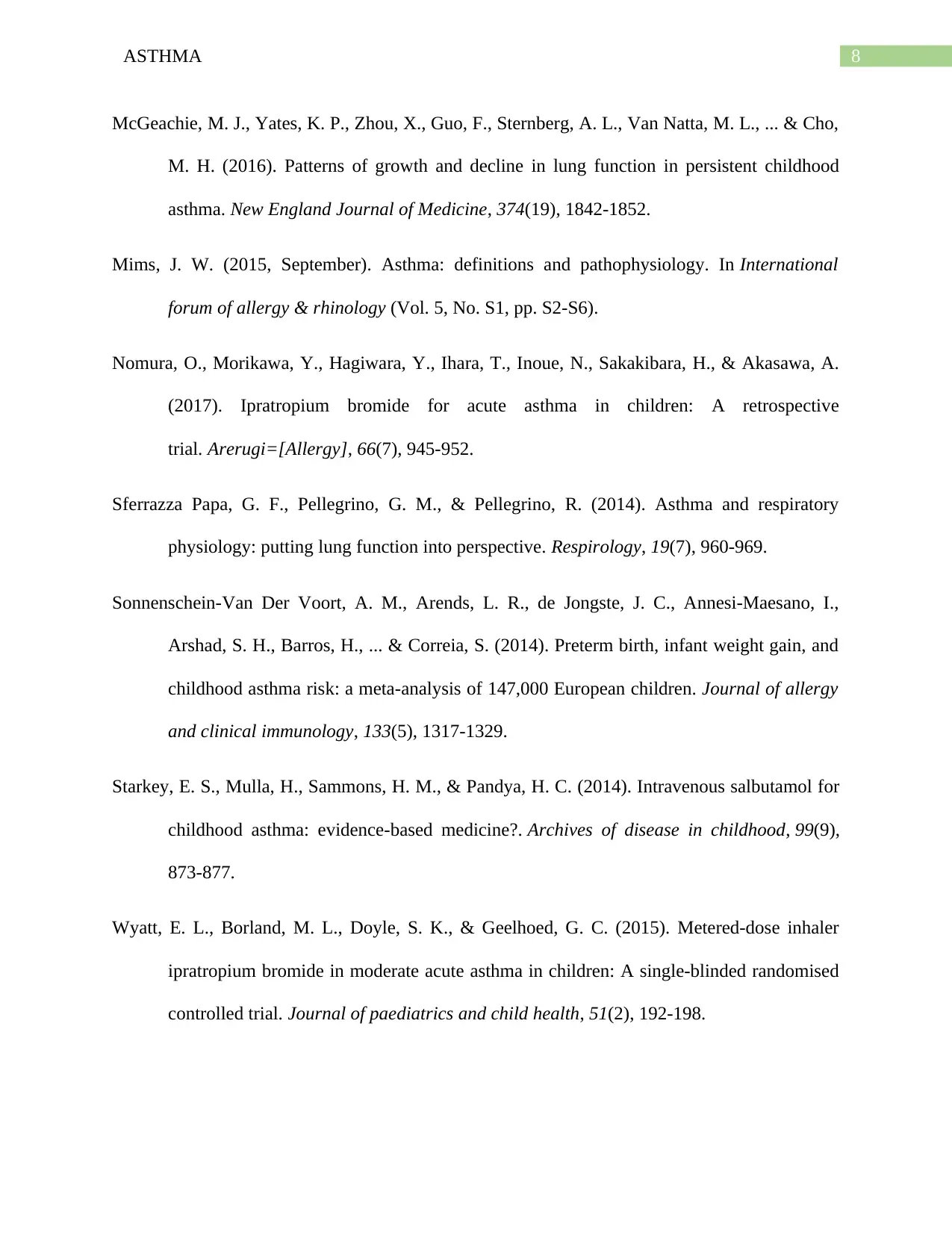
8ASTHMA
McGeachie, M. J., Yates, K. P., Zhou, X., Guo, F., Sternberg, A. L., Van Natta, M. L., ... & Cho,
M. H. (2016). Patterns of growth and decline in lung function in persistent childhood
asthma. New England Journal of Medicine, 374(19), 1842-1852.
Mims, J. W. (2015, September). Asthma: definitions and pathophysiology. In International
forum of allergy & rhinology (Vol. 5, No. S1, pp. S2-S6).
Nomura, O., Morikawa, Y., Hagiwara, Y., Ihara, T., Inoue, N., Sakakibara, H., & Akasawa, A.
(2017). Ipratropium bromide for acute asthma in children: A retrospective
trial. Arerugi=[Allergy], 66(7), 945-952.
Sferrazza Papa, G. F., Pellegrino, G. M., & Pellegrino, R. (2014). Asthma and respiratory
physiology: putting lung function into perspective. Respirology, 19(7), 960-969.
Sonnenschein-Van Der Voort, A. M., Arends, L. R., de Jongste, J. C., Annesi-Maesano, I.,
Arshad, S. H., Barros, H., ... & Correia, S. (2014). Preterm birth, infant weight gain, and
childhood asthma risk: a meta-analysis of 147,000 European children. Journal of allergy
and clinical immunology, 133(5), 1317-1329.
Starkey, E. S., Mulla, H., Sammons, H. M., & Pandya, H. C. (2014). Intravenous salbutamol for
childhood asthma: evidence-based medicine?. Archives of disease in childhood, 99(9),
873-877.
Wyatt, E. L., Borland, M. L., Doyle, S. K., & Geelhoed, G. C. (2015). Metered‐dose inhaler
ipratropium bromide in moderate acute asthma in children: A single‐blinded randomised
controlled trial. Journal of paediatrics and child health, 51(2), 192-198.
McGeachie, M. J., Yates, K. P., Zhou, X., Guo, F., Sternberg, A. L., Van Natta, M. L., ... & Cho,
M. H. (2016). Patterns of growth and decline in lung function in persistent childhood
asthma. New England Journal of Medicine, 374(19), 1842-1852.
Mims, J. W. (2015, September). Asthma: definitions and pathophysiology. In International
forum of allergy & rhinology (Vol. 5, No. S1, pp. S2-S6).
Nomura, O., Morikawa, Y., Hagiwara, Y., Ihara, T., Inoue, N., Sakakibara, H., & Akasawa, A.
(2017). Ipratropium bromide for acute asthma in children: A retrospective
trial. Arerugi=[Allergy], 66(7), 945-952.
Sferrazza Papa, G. F., Pellegrino, G. M., & Pellegrino, R. (2014). Asthma and respiratory
physiology: putting lung function into perspective. Respirology, 19(7), 960-969.
Sonnenschein-Van Der Voort, A. M., Arends, L. R., de Jongste, J. C., Annesi-Maesano, I.,
Arshad, S. H., Barros, H., ... & Correia, S. (2014). Preterm birth, infant weight gain, and
childhood asthma risk: a meta-analysis of 147,000 European children. Journal of allergy
and clinical immunology, 133(5), 1317-1329.
Starkey, E. S., Mulla, H., Sammons, H. M., & Pandya, H. C. (2014). Intravenous salbutamol for
childhood asthma: evidence-based medicine?. Archives of disease in childhood, 99(9),
873-877.
Wyatt, E. L., Borland, M. L., Doyle, S. K., & Geelhoed, G. C. (2015). Metered‐dose inhaler
ipratropium bromide in moderate acute asthma in children: A single‐blinded randomised
controlled trial. Journal of paediatrics and child health, 51(2), 192-198.
⊘ This is a preview!⊘
Do you want full access?
Subscribe today to unlock all pages.

Trusted by 1+ million students worldwide
1 out of 9
Related Documents
Your All-in-One AI-Powered Toolkit for Academic Success.
+13062052269
info@desklib.com
Available 24*7 on WhatsApp / Email
![[object Object]](/_next/static/media/star-bottom.7253800d.svg)
Unlock your academic potential
Copyright © 2020–2025 A2Z Services. All Rights Reserved. Developed and managed by ZUCOL.





